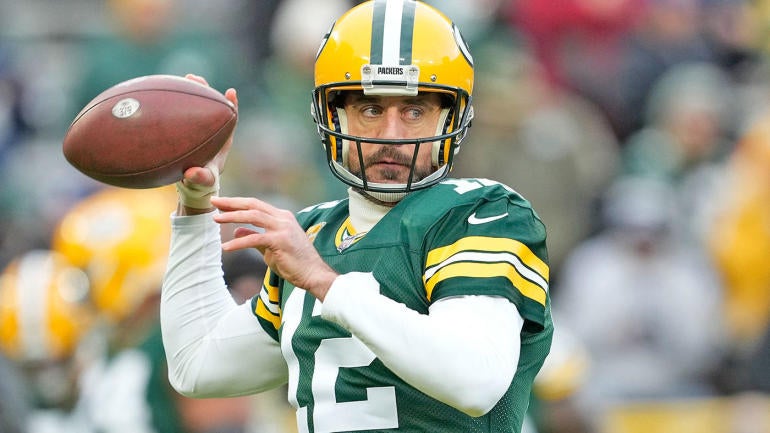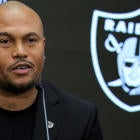
It's been over a month since Aaron Rodgers went on "The Pat McAfee Show" and gave what felt like the definitive turn toward his departure from the Green Bay Packers. The four-time NFL MVP stated that it was his intention to play for the New York Jets this coming season, paving the way for these two teams to then hammer out a trade. Since then, however, no trade has been executed and all sides of this saga are at a standstill with Rodgers floating in NFL purgatory.
The Packers' asking price for Rodgers and the Jets' unwillingness to meet it to this point has us in a Cold War where things have remained stagnant since the QB's declaration in March. But who has the leverage at this point with the NFL Draft less than a week away? Below, we'll dive into the case for each side of this coin, while also highlighting some possible snags that could turn this entire ordeal upside down, and a look at the time frame for when something could happen.
Why the Packers own the leverage
Green Bay has control of the asset, which puts them in a power position. If they don't feel like they are getting adequate value in return from New York, they could simply elect to keep him in-house and hammer things out with the player internally. The Packers reportedly want a first-round pick included in the deal and New York is unwilling to go that far. In Green Bay's view, the addition of Rodgers would immediately turn the Jets into a contender, so why would they settle for anything less?
Meanwhile, the Packers could look to pivot to another trade partner somewhere else in the league. Just because Rodgers said it was his intention to play for the Jets doesn't necessarily lock in that fate. If another club comes out of the woodwork (San Francisco? Tennessee? Tampa Bay? Washington?) and is willing to meet Green Bay's asking price, that puts New York in a tough spot.
The Jets don't have a clear-cut Plan B if this pursuit of Rodgers falls through. With free agency already coming and going, there are no great options at quarterback out there on the open market. The No. 13 overall selection -- where the Jets are slated to pick in the first round next Thursday -- also may not have a quarterback readily available to them. So, that would leave the Jets with what they have on the roster -- Zach Wilson, Tim Boyle, and Chris Streveler -- along with whatever else they could find in the bargain bin. With New York somewhat painting itself into a corner, the Packers argument is either to meet their price and trade for Rodgers or continue being a bottom-dweller in the AFC because of the lack of a solid quarterback.

With The First Pick Newsletter
With The First Pick Newsletter
Prepare for the upcoming NFL Draft with the day’s big stories + mock drafts, big board updates and more.
Thanks for signing up!
Keep an eye on your inbox.
Sorry!
There was an error processing your subscription.
Green Bay also has time on its side. They have no real rush to get this deal done and could drag it out as long as possible until they get their preferred asking price. The Jets ideally would want to bring Rodgers aboard for the offseason program to get acquainted with the organization and hit the ground running with the playbook. As CBS Sports' Joel Corry notes, it would make financial sense for the Packers to wait until June 2 to make the trade as Rodgers' cap charge wouldn't accelerate onto the team's 2023 salary cap and instead would push to 2024, freeing up $15.79 million in space.
Why the Jets own the leverage
New York does have Rodgers in its corner and that can't be overlooked. He's said publicly that he wants to play for the Jets, which essentially locks the Packers in a room with New York until they can hammer out a deal. While it may not be the most financially savvy move, Rodgers can threaten to retire and leave the Packers without any ability to get assets in return for their legendary quarterback. Or Rodgers could simply threaten to return to the team, throwing a wrench into their plans to allow former first-round pick Jordan Love to ascend to QB1.
While the Packers could technically try and bring in another trade partner, Rodgers can sink the deal if he openly says he won't play for that organization and digs his feet in solely with the Jets.
From an asking price perspective, New York can throw Rodgers' seesawing from the last couple of years against the Packers. Why would the team give up a future first-round pick for a 39-year-old quarterback that appears to be on a year-to-year basis at this point? There's the possibility that this Rodgers experiment could last for just a single season and he elects to retire after 2023, putting the Jets back into the QB market this time next year only without a first-round pick.
Really, Rodgers can hold the power here if his central focus is to get to New York and leaves Green Bay with no other realistic options.
When could a deal get done?
The NFL Draft could be a fascinating juncture for this deal to get done, specifically on Day 2. New York's first-round pick this year doesn't seem to be in the conversation as it pertains to acquiring Rodgers, but the Jets do have two second-round picks at No. 42 and No. 43 overall. It's possible that one or both of those selections could be a pivotal part to get this trade finally completed. Beyond this draft, we could be bunkering down into the early days of summer as these teams then look to the 2024 and 2025 drafts for possible compensation. The longer this situation moves without a resolution, it'll be interesting to see if the Jets break and give up a first-rounder, especially if we get close to the start of minicamp. At that point, you'd want to have your star QB in-house by any means necessary, right?
























